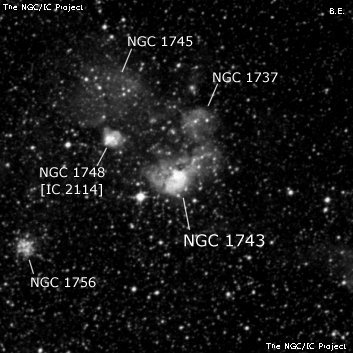
James Dunlop discovered NGC 1743 = D 114 = h2699 on 3 Aug 1826 and described "a small round nebula, about 20" diameter, bright at the centre." John Herschel recorded this object on 3 Nov 1834 as "round, gradually brighter in the middle; 2' (thick haze)." He next saw it as "bright, round, resolvable; No. 2 in a group of four forming a sort of lozenge." The four objects he refers to are NGC 1737, 1743, 1745 and 1748.
Joseph Turner sketched these four nebulous clusters on 13 Nov 1876 using the 48" Great Melbourne Telescope (plate III, figure 22). The orientation of the objects is not very good (even if north is not at the top) and NGC 1743 is shown as a very elongated, curvy nebulosity oriented N-S. Pietro Baracchi's sketch on 13 Nov 1884 appears to show NGC 1743 in two sections; the northern part elongated elongated NW-SE and ending near NGC 1737 and the southern part has a comet-like appearance surrounding a star. In a short report by Ellery in The Observatory, 9, 204, he mentions that NGC 1737, 1743, 1745 and 1748 appeared to show distinct differences, not only since John Herschel's time, but between Turner's and Baracchi's observations.
The gaseous nature of NGC 1743 was first found by Annie Jump Cannon on spectrum plates taken at Harvard's Arequipa station in 1897 and was catalogued as HD 31947. NGC 1743 is misclassified as an planetary nebula on the Skalnate Pleso "Atlas of the Heavens" as well as the Sky Atlas 2000.0 based on the HD spectral class.
600/800mm - 24" (11/18/12 - Magellan Observatory, Australia): brightest section of an excellent HII/cluster complex including NGC 1737, 1745, 1748 and 1756. At 200x, NGC 1743 appeared very bright, moderately large, ~50" diameter. Contains a very high surface brightness "core" with a fairly bright star involved. A larger "halo" extends mostly north amd roughly doubles the size to ~1.7'. NGC 1737, a faint extension with a couple of stars involved, is 1.8' NNW. NGC 1743 and NGC 1748 (a bright high surface brightness knot 2' NE) are embedded within a very large, irregular, low surface brightness haze extending ~3' (stellar association LH 5 and emission nebula LMC-N83), oriented roughly from NGC 1743 on the SW side to NGC 1745 on the NE end.
Notes by Steve Gottlieb